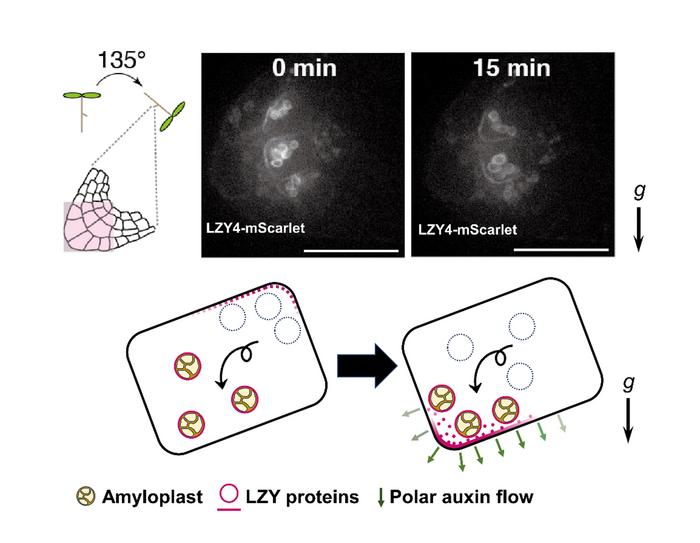Plants orient their organs in response to the gravity vector, with roots growing towards gravity and shoots growing in the opposite direction. The movement of statoliths responding to the inclination relative to the gravity vector is employed for gravity sensing in both plants and animals. However, in plants, the statolith takes the form of a high-density organelle, known as an amyloplast, which settles toward gravity within the gravity sensing cell. Despite the significance of this gravity sensing mechanism, the exact process behind it has eluded scientists for over a century. A groundbreaking study led by Professor Miyo Terao Morita at the National Institute for Basic Biology (NIBB) in Japan has revealed that the translocation of signaling proteins from amyloplasts to the plasma membrane is the key to deciphering this enigmatic mechanism. The research, titled “ Cell polarity linked to gravity sensing is generated by LZY translocation from statoliths to the plasma membrane,” is now available online in Science ahead of print.

Credit: National Institute for Basic Biology/T. Nishimura et al.
Plants orient their organs in response to the gravity vector, with roots growing towards gravity and shoots growing in the opposite direction. The movement of statoliths responding to the inclination relative to the gravity vector is employed for gravity sensing in both plants and animals. However, in plants, the statolith takes the form of a high-density organelle, known as an amyloplast, which settles toward gravity within the gravity sensing cell. Despite the significance of this gravity sensing mechanism, the exact process behind it has eluded scientists for over a century. A groundbreaking study led by Professor Miyo Terao Morita at the National Institute for Basic Biology (NIBB) in Japan has revealed that the translocation of signaling proteins from amyloplasts to the plasma membrane is the key to deciphering this enigmatic mechanism. The research, titled “ Cell polarity linked to gravity sensing is generated by LZY translocation from statoliths to the plasma membrane,” is now available online in Science ahead of print.
For years, researchers speculated on the gravity sensing mechanism, with hypotheses such as the force sensing model and position sensing hypothesis. However, definitive evidence for each remained elusive, until now. In their earlier work, the team discovered that Arabidopsis LAZY1-LIKE (LZY) proteins play a crucial role in gravity signal transduction, with polar localization at the plasma membrane on the side of gravity. Nevertheless, the exact mechanism establishing this remarkable localization remained unknown.
Through sophisticated live cell imaging techniques, including vertical stage microscopy and optical tweezers, the research team made a significant breakthrough. They found that LZYs not only localize at the plasma membrane near amyloplasts but also at the amyloplasts themselves. “The plasma membrane localization of LZYs surprised us, as it is generated by the close proximity of amyloplasts to the membrane,” explained Takeshi Nishimura, Assistant Professor at NIBB and the first author of the study.
“We demonstrated that localization on both the plasma membrane and amyloplasts is necessary for gravity signaling in roots, indicating its fundamental role in this process,” added Hiromasa Shikata, Assistant Professor at NIBB and the co-first author.
Professor Miyo Terao Morita further emphasized, “LZYs act as signal molecules, transmitting positional information from amyloplasts to the plasma membrane, where the regulation of auxin transport occurs.” This revelation provides compelling support for the “position sensor hypothesis,” explaining gravity sensing in plants through the proximity or the contact between statoliths and the plasma membrane.
LAZY1 was originally identified as the responsible gene for the rice gravitropism mutant. Its counterparts are conserved across various land plants, pinpointing their fundamental significance. The distinctive “lazy” phenotype, marked by the lateral spreading of branches and roots, has manifested in mutants of these genes in various plant species, including crops. Further studies on LZY may impact technology for controlling plant architecture and production.
###
Paper Information
Journal
Science
Authors
Takeshi Nishimura§, Shogo Mori §, Hiromasa Shikata§, Moritaka Nakamura, Yasuko Hashiguchi, Yoshinori Abe, Takuma Hagihara, Hiroshi Y. Yoshikawa, Masatsugu Toyota, Takumi Higaki, Miyo Terao Morita
§, these authors equally contributed to this work
Journal
Science
DOI
10.1126/science.adh9978
Method of Research
Experimental study
Subject of Research
Cells
Article Title
Cell polarity linked to gravity sensing is generated by LZY translocation from statoliths to the plasma membrane.
Article Publication Date
10-Aug-2023




